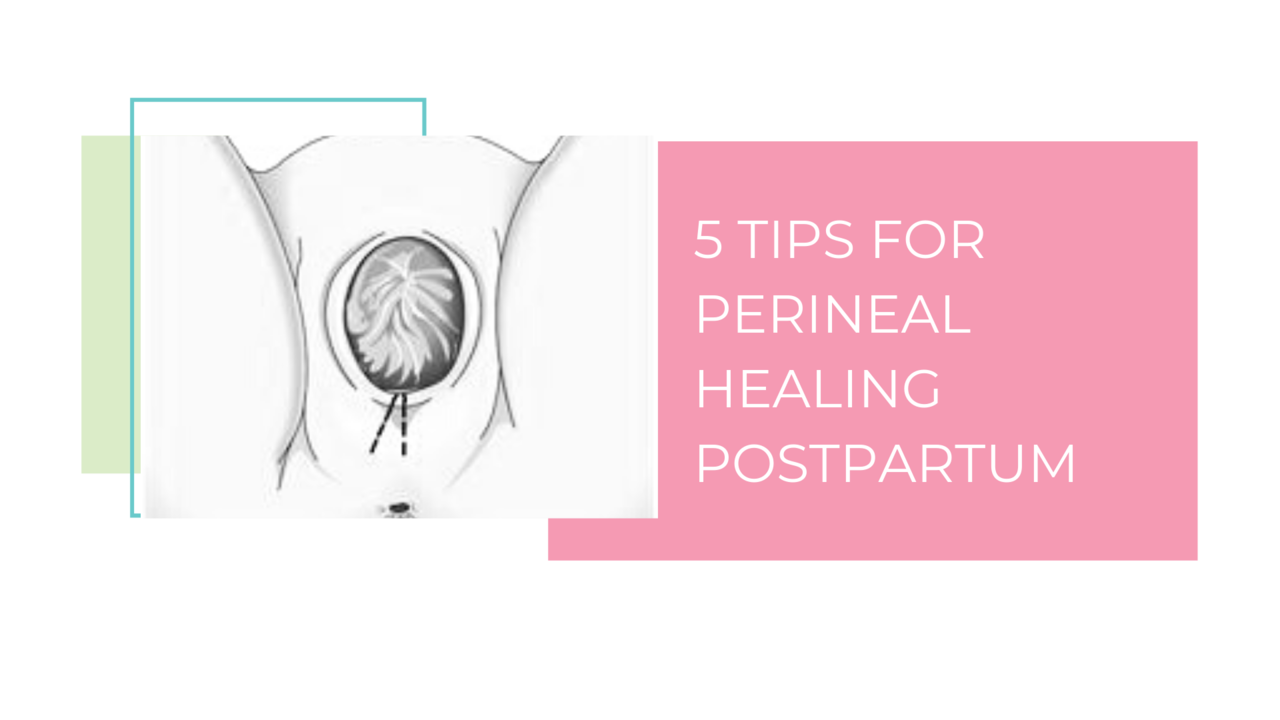
5 Tips for Perineal Healing Postpartum
Dec 19, 2019
Recovering After a Perineal Tear
The possibility of a perineal tear is probably the number one fear of pregnant women – how the heck am I going to push a baby out of my vagina and stay in one piece!?!
Episiotomy used to be a routine procedure that was once thought to help increase the space for the baby to emerge and protect women from dysfunction created by tearing. It turns out the procedure designed to protect actually created more dysfunction and perineal trauma. Thankfully, the procedure is rarely performed these days.
Tearing, while not ideal, is better than an episiotomy. Tears are classified in four degrees of severity, with fourth-degree being the worst.
- A first-degree tear involves the fourchette (where the labia minora meet posteriorly), the perineal skin and the vaginal mucosa (membranes or linings).
- A second-degree tear involves the above-mentioned areas and extends to the perineal or pelvic floor muscles.
- A third-degree tear involves the fourchette, membranes, muscles of the pelvic floor and the anal sphincter.
- A fourth-degree tear involves all of the above including the rectal mucosa (membranes).
Having an episiotomy can increase the likelihood of suffering from a third or fourth-degree tear.
Tearing and episiotomy can be avoided or minimized through things like perineal massage, optimizing birth position, caregiver support such as warm compresses and oil, and not pushing while the head is crowning.
There are, however, instances when tearing does occur despite all of the best intentions and preparation. Even if a woman births through an intact perineum, the tissue and muscles need time to heal and recover.
Below are some of my favourite postpartum healing tricks.
Rest and Ice (First 24 Hours)
Like any swollen tissue, the perineum and pelvic floor respond well to the ice to reduce inflammation and pain. Ice should not be applied directly to the skin, so using a thin panty or baby washcloth as a layer will protect the delicate area.
You can use a bag of frozen peas or crushed ice but what I found easiest was to use frozen maxi pads or condoms. For the pads, soak in water (or a healing herbal tea of your choice) and then place in a Ziploc bag in the freezer. Take one out when you're ready to use it and place it inside your underwear with a thin layer on top between the pad and your skin.
For the condoms, fill the condom about ½ full with water and tie the end. Place it in the freezer and when you're ready to use it, take it out and place it inside your underwear as above, with a thin layer between your skin and the condom.
I have also experimented with Lunapads and they work very well (would have been my first choice if I had known about them when I was pregnant). I found that after I took the frozen liner out of the freezer it was best to allow 2-3 minutes for it to thaw slightly before placing it in the underwear.
Rest and Heat
After the initial 24-hour period I suggest switching to soothing gentle heat in the form of warm sitz baths, compresses or peri bottles. You can use an actual sitz bath but I chose to enjoy a full-on bath several times a day.
I used a postpartum perineal healing tea from a local health food store and made a big batch of it every day (actually my mom did – Thanks Mom!!). I kept it in the fridge and added a cup of tea to each bath I took.
You can also soak your Lunapad in the mixture and apply it directly to the perineum as a compress. Another option is to use the healing mixture in a peri bottle and spray on your perineum after going to the washroom and several times throughout the day.
Some common herbs used for perineal healing are comfrey, yarrow, rosemary, goldenseal, witch hazel, thyme, lavender, calendula, myrrh, and aloe vera. You can ask your midwife for her favourites, visit your local health food store or purchase ready-made mixtures from companies that make perineal healing blends.
Core Breathing
As soon as 24 hours after delivery I recommend women incorporate core breathing throughout their day to help restore function to the deep core system.
This will help promote circulation and oxygenation to the healing tissues, it will help regenerate tone and strength to the pelvic floor muscles, and it will encourage connective tissue healing and engagement of the deep abdominals to start closing any separation of the muscles.
Read my full post about breathing to restore your core.
Avoid Impact
The main focuses of the early postpartum days are rest, healing and breastfeeding.
Ideally, the rest includes sitz baths and lying down, which will allow the pelvic floor time to heal and recover from the strain of pregnancy and delivery. By lying down and avoiding even gentle impact, it takes the downward pull of gravity out of the equation to allow for optimal healing.
Recruit your family and friends to help so you can focus on yourself and your baby. I recommend light walking after about four weeks with gradual increases in length of time, speed of walking or walking on an incline.
I feel it is best to avoid high impact activities like running until at least six months postpartum or once you have seen a pelvic floor physiotherapist who has determined your core function is ok to return to such activities.
See a Pelvic Floor Physiotherapist
“I never knew there were physiotherapists who work with the pelvic floor." I hear that all the time and I am working hard to increase awareness of pelvic floor health and promote the wonderful professionals available to you and your pelvic floor.
Most literature, baby books, etc. suggest that by six weeks postpartum you have a green light to return to activity. This is a very general guideline and an irresponsible one in my opinion.
New moms are simply not ready for rigorous activity at six weeks, yet I see them lining up for CrossFit, boot camps and running groups hoping to get back into their pre-pregnancy clothes.
Instead, I suggest that women follow the Core Confidence Exercise Program for the first 8 weeks postpartum. Then at eight weeks, every woman sees a pelvic floor physiotherapist. Having an internal assessment and functional testing of your pelvic floor is so valuable and is key to treating and preventing common types of dysfunction, such as incontinence and prolapse. From there you can gradually progress back to the activities you desire.
My Buff Muff Challenge is a great way to retrain your core and pelvic floor after your 8-week visit with your physio.
The Buff Muff App
The Buff Muff App will help you finally get clarity on the elusive kegel and teach you how to activate your pelvic floor appropriately and then add it to movement. There is a ton of free content available to anyone who downloads the app including a 7-day pelvic floor fitness challenge to introduce you to the concept of a whole-body fitness approach to pelvic health. Once the free challenge ends you have the option to join the membership for ongoing support from me, your very own vagina coach.
You deserve body confidence and it all starts with the pelvic floor!
Available on iPhone and Android





